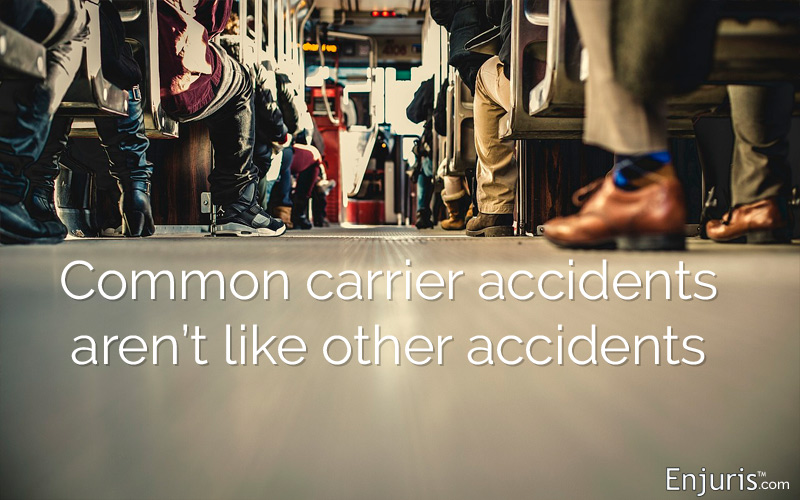Hablamos español.
What happens when a vehicle designed to transport passengers like a bus or a taxi is involved in an accident in Texas?
There’s an illusion of control when you’re driving a vehicle. This illusion is based, in part, on the fact that people tend to falsely attribute a chance outcome to their own skill.
For most people, the illusion of control is shattered when they’re a passenger in a taxi, bus, or some other vehicle designed to transport the public as part of a business. Making matters worse, most people don’t know exactly what happens if they’re injured in an accident as a passenger of a transport vehicle.
Is the driver responsible? Is the company that owns the vehicle responsible? What if you’re injured while traveling on public transportation? Can the government be sued?
Let’s take a close look at common carrier accidents in Texas.
What’s a common carrier (and how does common carrier status impact your personal injury claim)?
The term “common carrier” refers to any individual or business transporting people in exchange for money. Common examples include:
- Public buses
- Private bus lines (Coach, Greyhound)
- School buses
- Airport and hotel shuttle buses
- Tour buses
- Taxis
- Ride-share vehicles
- Light rail
Dallas Area Rapid Transit (DART) v. David Morris
In Dallas Area Rapid Transit v. David Morris, lawyers for Dallas Area Rapid Transit (DART), argued that DART wasn’t a common carrier because the transit system wasn’t operated for profit. Rather, the transit system was funded primarily by grants and tax dollars.
The court explained that common carriers are “those in the business of carrying passengers and goods who hold themselves out for hire by the public.” The court went on to explain that when determining whether someone is a common carrier, it looks primarily at their “function.”
In other words, the court examines whether the business of the person or entity is transportation or whether transportation is only incidental to the person or entity’s business.
As an example, the court pointed out that a speed boat operator isn’t generally considered a common carrier because the primary function of the speed boat operator is to entertain, rather than to transport people from place to place.
In holding that DART was, in fact, a common carrier, the court made clear that common carriers include trains, buses, airplanes, taxis, street cars, and other vehicles designed to take members of the public from one place to another.
Whether or not an individual or business is a common carrier is important because common carriers are held to a higher degree of care than regular drivers. The Texas Supreme Court described this degree of care as follows:
“A common carrier is under a duty to exercise such a high degree of foresight as to possible dangers and such a high degree of prudence in guarding against them, as would be used by a very cautious, prudent, and competent man under the same or similar circumstances.”
Practically speaking, this simply means that it’s easier to find a common carrier negligent than it is to find a “regular driver” negligent.
For the purposes of proving negligence, a regular driver is held to the standard of an “ordinary, reasonable person.” If the person fails to behave as an ordinary, reasonable person would, the person is negligent.
On the other hand, a common carrier must behave as a “very cautious, prudent, and competent person.” If the common carrier fails to do so and you’re injured as a result, the common carrier is negligent.
Who can be held liable for a bus or taxi accident in Texas?
When it comes to determining who is negligent in the case of a common carrier accident, there are several parties that can be held liable, including:
- The driver (bus driver, taxi driver, etc.)
- The owner of the vehicle
- The manufacturer of the vehicle (manufacturers are generally only liable in cases involving a defective vehicle or vehicle part)
- The company or individual who failed to properly maintain the vehicle
Any other party whose negligence resulted in the accident (such as a driver of a motor vehicle who caused the common carrier accident).
What if the common carrier is a government entity?
Many forms of public transportation are owned by government entities. For example, a school bus may be owned by a city or county. Government entities can be sued just like regular businesses or people. However, there are a couple of important differences.
First, a different statute of limitations applies.
In Texas, a lawsuit filed against a government entity must be filed within 180 days of the incident giving rise to the lawsuit.
Second, when suing a government entity, you must provide the entity with written notice of the lawsuit before filing the lawsuit.
What causes common carrier accidents?
Just like regular car accidents, a number of things can cause accidents involving common carriers, such as:
- Driver negligence
- Inexperience
- Sleepiness/excessive fatigue
- Inattention
- Lack of maintenance
- Road rage
- Inadequate training
- Driving under the influence
- Tire blowout
- Speeding
- Mechanical failure
Common injuries and available damages
As with regular car accidents, injuries suffered in a common carrier accident range from minor to catastrophic and may include:
- Traumatic brain injuries
- Neck and back injuries
- Whiplash and spinal cord injuries
- Burns
- Amputations
- Broken bones
- Lacerations
Remember, to receive compensation, the at-fault party must be liable. Once liability has been established, you can recover the following damages in Texas:
- Medical expenses. You can be compensated for past and future medical expenses. This includes hospitalization after the accident and any therapy or medications needed during the recovery period.
- Lost wages. You may receive compensation for any missed time at work due to your recovery from your injuries.
- Pain and suffering. Emotional trauma is a real possibility after a common carrier accident. You may receive compensation for this trauma.
- Wrongful death. If a loved one is killed because of a common carrier accident, certain family members can receive compensation for funeral costs, loss of companionship, loss of income, etc.
Keep in mind that Texas follows the modified comparative fault theory. This means that your damages are reduced according to your degree of fault.
For example, if you’re found 30% at fault for the common carrier accident, and the other party is found 70% at fault, you will only be able to recover 70% of your damages. What’s more, if your degree of fault exceeds 50%, you’re prohibited from recovering any damages.
In a common carrier accident, it’s not unusual for your damages to add up quickly. It might put your mind at ease to know that Texas requires common carriers to carry liability insurance.
In Texas (as well as other states), ride-share drivers are required to carry $1 million in liability insurance.
Buses must carry at least $500,000 in liability insurance if they have at least 15 passengers (but no more than 26). If buses have 26 passengers or more, they must carry at least $5 million in liability insurance.
Commercial motor vehicles (trucks, for instance) need at least $500,000 in liability insurance as well, while foreign commercial motor vehicles need at least $750,000.
What should you do if you’re involved in a common carrier accident?
Whether you are the passenger or driver, there are certain steps you should take after an accident involving a bus, taxi or other common carrier.
The first thing you need to do following a common carrier accident is to check yourself for physical injuries. If you’re injured, seek medical attention as soon as you can.
Once you know that you’re okay, help anyone else who needs medical attention, and get your vehicle out of the flow of traffic if you can. If you can’t move your vehicle because of damage, at least put on your hazard lights.
Once you’re satisfied that you and everyone else is safe, there are 2 things you can do that will help your chances at recovering damages in any future insurance claim or lawsuit:
1. Collect information from the scene of the accident
As long as it’s safe to do so, collect as much information from the accident scene as possible. Important information that may help your claim or lawsuit includes:
- Photographs. Be sure to take photographs of the accident scene, any vehicle damage, and any physical injuries.
- Statements. Be sure to give your statement to the responding police officer so that it can be added to the police report. In most cases, you can obtain your police report online after your accident.
- Witness information. Witnesses are notoriously difficult to track down after an accident. Without hassling anyone, obtain the contact information for any potential witnesses (name, address, telephone number, etc.). You can also obtain a signed or recorded witness statement. But remember, you don’t want to do anything that will anger any potentially supportive witnesses.
- Contact information for the other driver. Be sure to collect the information for the other driver. This information should include contact information (name, address, telephone number), license number, and insurance information.

Sample post-accident report form to keep in your glove box - fill out at the scene or as soon as you can after a car accident
Download in PDF format
2. Seek medical attention and document everything
Following a common carrier accident, it’s important to seek medical attention even if you don’t think you were injured. For some injuries, the symptoms don’t appear until days (or even weeks) later. For this reason, you’ll want to seek medical attention following your accident no matter what.
What’s more, by seeking medical attention, you’ll eliminate the possibility that the at-fault party will successfully argue that you weren’t really injured or that you didn’t take reasonable steps to mitigate your damages.
In addition to seeking medical attention, it’s important to document your injuries and medical treatment. The forms below can help:

Sample accident journal/diary to help you document the effect on your daily life
Download in PDF format

Damages worksheet to track expenses for your injury claim (medical treatment, property damage, lost wages, prescriptions)
Download in PDF format
See our guide Choosing a personal injury attorney.


